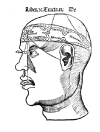Depth psychology
| Psychology |
| History |
| Psychologists |
| Divisions |
|---|
| Abnormal |
| Applied |
| Biological |
| Clinical |
| Cognitive |
| Comparative |
| Developmental |
| Differential |
| Industrial |
| Parapsychology |
| Personality |
| Positive |
| Religion |
| Social |
| Approaches |
| Behaviorism |
| Depth |
| Experimental |
| Gestalt |
| Humanistic |
| Information processing |
Depth psychology is a broad term that refers to any psychological approach that examines the depth (the hidden or deeper aspects) of human experience. Although not based on a religious foundation, depth psychology attempts to bring the concept of soul and other spiritual aspects of human life into psychology.
Origin and development
Depth psychology, from the German term (Tiefenpsychologie) coined by Eugen Bleuler, refers to the ongoing development of theories and therapies pioneered by Pierre Janet and Carl Jung, with contributions by Sigmund Freud, Alfred Adler, Otto Rank, and others.
This approach provides a set of techniques for exploring underlying motives and a method of treating various mental disorders. It seeks to understand the "deep" layer(s) underlying behavioral and cognitive processes—the realm of the unconscious. The three major schools of depth psychology are:
- Analytical psychology, based on the work of Carl Jung
- Individual psychology, based on the work of Alfred Adler
- Psychoanalysis, based on the work of Sigmund Freud
Also influential in the development of depth psychology are transpersonal psychology, which in itself includes humanistic psychology, and existentialism, which has worked its way into the world of psychotherapy primarily via the work of Rollo May. The work of Rudolf Steiner, on our ability to participate in spiritual processes, influenced the development of Robert Sardello's spiritual psychology, which, along with James Hillman's archetypal psychology (an outgrowth of Jung's analytical school) and the work of Roman Catholic theologian Thomas Moore, brought a focus on the soul and the deepest patterns of psychic functioning.
Key concepts
The following are the primary elements of depth psychology:
Conscious and unconscious
Depth psychology states that the psyche is a process that is partly conscious and partly unconscious. The unconscious contains repressed experiences and other personal issues in its "upper" layers, and "transpersonal" (e.g. collective and archetypal) forces in its depths.
Spiritual and instinctive
The psyche spontaneously generates mythico-religious symbolism and is therefore spiritual, as well as instinctive, in nature. According to depth psychology, this implies that the choice of being a spiritual person or not does not exist—the only question is where do we put our spirituality. Do we live it consciously, or do we unknowingly invest it in unspiritual aspirations (perfectionism, addictions, greed, fame) that eventually possess us by virtue of their ignored, but frightfully potent, noumenous power?
Myth-making
All minds, and all lives, are ultimately embedded in some sort of myth-making. Mythology is not merely a series of old explanations for natural events; it is rather the richness and wisdom of humanity played out in a wondrous symbolic storytelling: no story, no myth, and no humanness either.
Caring for our environment
Depth psychology notes that because of our deep connection to all that surrounds us, we are sane and whole only to the degree that we care for our environment and tend responsibly to the world in which we live.
Soul
One of the aims of depth psychology is to bring discussion of the soul back into psychology. The soul is the “seat of meaningful experience” where the psyche’s personal and transpersonal poles meet. James Hillman refers to it as an imaginative deepening of events into experiences.
Influence
Depth psychology has profoundly influenced the way many psychologists and counselors approach their clients' experiences. Understanding that there exists an unconscious realm, containing both personal and transpersonal, or collective, aspects, is the first step in unraveling the intricacies of the human psyche. Nevertheless, religious practitioners, specifically Christians, may say that the approach is still deficient; including the soul in psychology is a good first step, but understanding God's purpose for creating humankind is also essential. However, for psychology to include such religious components while maintaining its scientific status remains a challenge.
Nevertheless, support for depth psychology's pursuit of spiritual components underlying human behavior comes from the field of quantum physics. Late twentieth-century advances in this field have led scientists to posit that at a very deep level there is no distinction between physical and psychic structures, and that these are actually two perspectives on the same core reality. In this way, efforts on the part of depth psychologists to bring spiritual concepts, such as the soul, into psychology contribute to bringing together the spheres of science and religion.
ReferencesISBN links support NWE through referral fees
- Hillman, James. 2004. Archetypal Psychology, Vol. 1: Uniform Edition of the Writings of James Hillman. Spring Publications. ISBN 0882145762.
- Moore, Thomas. 1994. Care of the Soul: A Guide for Cultivating Depth and Sacredness in Everyday Life. Harper Paperbacks. ISBN 0060922249.
- Sardello, Robert. 2001. Love and the World: A Guide to Conscious Soul Practice. Lindisfarne Books. ISBN 0970109741.
External links
All links retrieved July 26, 2022.
Credits
New World Encyclopedia writers and editors rewrote and completed the Wikipedia article in accordance with New World Encyclopedia standards. This article abides by terms of the Creative Commons CC-by-sa 3.0 License (CC-by-sa), which may be used and disseminated with proper attribution. Credit is due under the terms of this license that can reference both the New World Encyclopedia contributors and the selfless volunteer contributors of the Wikimedia Foundation. To cite this article click here for a list of acceptable citing formats.The history of earlier contributions by wikipedians is accessible to researchers here:
The history of this article since it was imported to New World Encyclopedia:
Note: Some restrictions may apply to use of individual images which are separately licensed.
